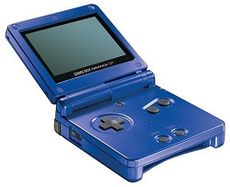From NintendoWiki, your source on Nintendo information. By fans, for fans.
Game Boy Advance SP
ゲームボーイアドバンスSP Gēmu Bōi Adobansu Essu Pī
|

|

Cobalt Game Boy Advance SP
|
|
| Media
|
Game Boy Advance Game Pak
|
| Storage capacity
|
32 kilobyte+96 kilobyte VRAM (internal CPU), 256 kilobyte DRAM (external CPU)
|
| CPU
|
32-bit 16.78 MHz ARM7TDMI, 8 or 4 MHz Z80 coprocessor
|
| Model no.
|
AGS-001 (original)
AGS-101 (later release)
|
|
|
|
| Launch date
|
NA: March 23, 2003
JP: February 14, 2003
PAL: March 28, 2003
|
| Discontinue date
|
2007
|
| Units sold
|
Total (WW): 43.57 million[1]
NA: 24 million[1]
JP: 6.51 million[1]
Other: 13.05 million[1]
|
|
| Predecessor
|
Successor
|
| N/A
|
N/A
|
|
The Game Boy Advance SP ("special"[2]) is the first redesign of the Game Boy Advance, and the fifth system to be released as part of the Game Boy line. The system was released in 2003, and in addition to having a different form factor, there are several changes to the hardware to cut the price.
Features
The Game Boy Advance SP is notable for being a complete redesign of the hardware. Rather than using a similar form factor to the original, the SP instead uses a more condensed "clamshell" design, calling back to the dual-screen Game & Watch units, meaning that the system can be closed to make transporting it easier. The top half is dedicated to the screen, while the bottom half features the buttons and speaker.
The Game Boy Advance SP is the first Nintendo handheld console to include a built-in rechargeable battery pack (AGS-003) rather than requiring a separate accessory or individual batteries; it can be charged using an AC Adapter wall plug (AGS-002), which is included with all systems. With the brightest screen settings and depending on the model, the system has a battery life of approximately 7-10 hours[3].
It is also the first Nintendo handheld to make use of built-in screen lighting. The Game Boy Advance SP has a frontlit screen, which can be turned on or off using the top center button on the system (later models would use a backlit screen). The external Game Link Cable port remains on the back of the system, along with an added "Port 2" for the charger, while the Game Pak slot has been added to the bottom of the system.
Games
The Game Boy Advance SP uses similar internal hardware to the Game Boy Advance, and as such is compatible with all games released for the system, including backwards compatibility for Game Boy and Game Boy Color games.
Accessories
The Game Boy Advance SP is compatible with most accessories and peripherals released for the Game Boy Advance.
Game Boy Advance SP Headphone Adapter
The Game Boy Advance SP Headphone Adapter is an adapter cable that allows compatibility with any 3.5mm audio jack when using a Game Boy Advance, as the hardware on its own does not have a port. The adapter plugs into Port 2 on the back of the SP, meaning that headphones and the AC Adapter cannot be used at the same time.
Play-Yan
Play-Yan is a multimedia cartridge capable of playing audio and video files on a Game Boy Advance SP or Game Boy micro. While compatible with the original Game Boy Advance, it is not recommended due to the cartridge's power requirement.
AGS-101
In September 2005 in North America and in 2006 in Europe, an updated version of the Game Boy Advance SP hardware with a different model number (AGS-101) was released. The most notable difference between the original model and this version is the inclusion of a backlit screen rather than a frontlit one, similar to those seen on the Game Boy micro and Nintendo DS. In addition, to accommodate this, the function of the lighting button was adjusted to be a "Brightness Switch", which selects between two levels of brightness rather than turning the backlight on or off.
Appearances in games
| Game
|
Year
|
Appearance(s)
|
| Mario & Luigi: Superstar Saga
|
2003
|
Professor E. Gadd gives Mario and Luigi the Game Boy Horror SP as the final gift he can give them at the Starbeans Café. The Game Boy Horror SP causes enemies to drop a rare item in every fight.
|
| Paper Mario: The Thousand-Year Door
|
2004
|
Mario has the Mailbox SP, which he uses to receive and read e-mails from other characters.
|
| WarioWare: Touched!
|
2004
|
- Wario starts the game having stolen a Game Boy Advance and a Game Boy Advance SP, but trips and drops both into a sewer. The Sewer Guru then flies up, asking whether he dropped the two handhelds or a new device, to which Wario responds by trying to take them all.
- A Game Boy Advance SP is one of the consoles that can appear in the "Pushing Buttons" microgame.
|
| Pikmin 4
|
2023
|
A Cobalt Blue Game Boy Advance SP appears as an item you can find in Pikmin 4, referred to as the "Stone of Advancement".
|
External links
References
|
|
| Hardware
|
|
| Components / other
|
|
|
|
|
|
|
|
|
| Other
|
| Standalone consoles
|
Arcade
|
Pokémon
|
Classics
|
Cancelled
|
|
|
|
|
|
|
|


